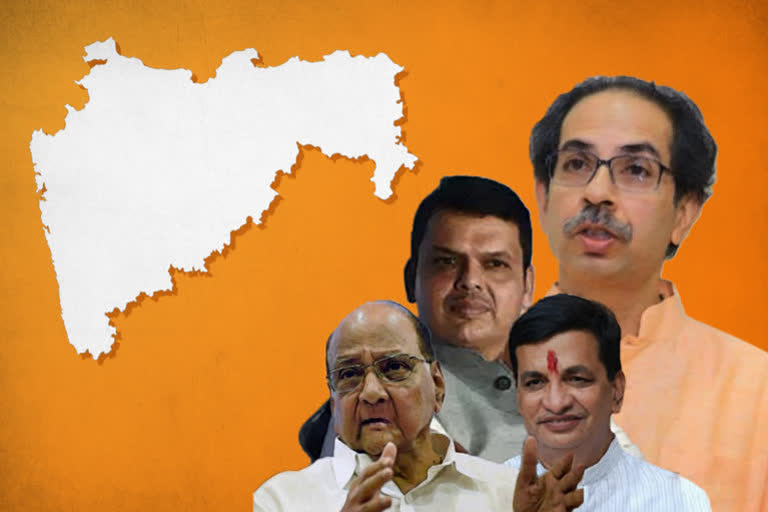Hyderabad: With just four days left for the closing of the campaign in the state assembly election, Western Maharashtra is likely to prove to be the main battleground for the two opposing camps, namely BJP-Sena alliance and Congress-NCP. Mumbai-Konkan region, meanwhile, is going to be very vital for Shiv Sena. Even though BJP looks to have an upper hand in the rest of the state, a number of rebels may force the party to change its calculations till the last minute.
Strong Base
Traditionally, Western Maharashtra (comprising Kolhapur, Sangli, Satara, Pune, and Solapur) was seen to be the bastion of Congress and NCP, especially the latter. Out of the total 41 seats won by NCP in 2014 assembly elections, 19 had come from Western Maharashtra. In the 2019 election, it won four seats, out of which three are from this region.
Also, just to keep things in perspective, in 2014 assembly elections, the NCP had won only eight seats in Marathwada and Konkan each, while just one out of 71 in Vidarbha. The Congress, on the other hand, had won 10 each in Western Maharashtra and Vidarbha, while just 9 (out of 46) in Marathwada.
Western Maharashtra, with a fairly equitable distribution of land-holding, wide spread of irrigation facilities, good rainfall and comparative proximity to Pune and Mumbai has always been more prosperous than others. Ever since the times of Chhatrapati Shivaji Maharaj, who hailed from here and ruled this part of the state for most part of his life, the region has been politically more active and alert. Hence, it was perhaps not a mere coincidence that one of the strongest cooperative movements in the country emerged from here and is still going strong in the region.
(Funny as it may sound, but the largest number of textile cooperatives are in Western Maharashtra even though the area under cotton here is almost zero. The cotton mainly comes from Vidarbha and Gujarat.)
The Congress and, later the NCP, have very firm roots in this movement. They have received help from this and in turn the cooperative sugar factories, dairies etc have benefitted from them being in power. Maratha is a dominant caste here and Maratha pride was finely entwined with the Congress politics so far.
Despite its best efforts, BJP could not even make a dent into this bastion for a very long time. However, it all changed in the 2014 elections. A slow disintegration of the cooperative movement, strong anti-incumbency and Congress-NCP leadership's incapability to cater to the aspirations of the youth and the Modi wave contributed to the BJP's significant success in 2014 when, out of the total 71 seats, it won 24 (the highest till then). Shiv Sena, which was then fighting separately, got 13 seats.
Aiming High
Five years later, BJP and Shiv Sena are aiming even higher. With the help of the power both at the state and the Centre, the parties consolidated their positions substantially in municipal corporations and panchayat in the past five years. Many cooperative tzars were either won over, maimed or made to cross over. In the last six to eight months, the region saw a tsunami of sorts when almost anybody who was associated with the Congress and NCP made a beeline to the BJP and Sena. Major families and their large supporters migrated. Mohite-Patils of Solapur, Mahadiks of Kolhapur, Bhosales of Satara are just a few names among many. In the biggest blow, NCP even lost its senior MP Udayanraje Bhosale to the BJP.
The impact is seen everywhere. Parth Pawar, the grandson of Sharad Pawar and son of Ajit Pawar, lost the Lok Sabha election from Maval in Pune district. Both the Lok Sabha seats in Kolhapur went to Shiv Sena, which had never happened before in the history of the state.
This has buoyed their confidence. Today, BJP is fighting 31 and Shiv Sena 28 seats in the region and their success rate is likely to be very high. For example, in Satara district, BJP could not win a single seat in 2014 despite the Modi wave. This time, it is likely to win at least four. In Pune city, it is contesting all the eight seats (zero to Shiv Sena) and going by Lok Sabha statistics, it would not be surprising if they win them all.
Most of the BJP and Sena candidates in this region were in Congress and NCP till recently. And in most cases, the Congress-NCP candidates are none other than their friends, associates and relatives, who have stayed back in these parties. Hence, quite interestingly, in the campaigning, the candidates are hardly raising any issues of any corruption or inefficiency against each other. The main issue of contention is ideological. The Congress and NCP are reminding of the secular tradition to which the people of the region remain loyal to this day. So, in a way, it is this tradition which is at the test in this region.
Maratha Factor
